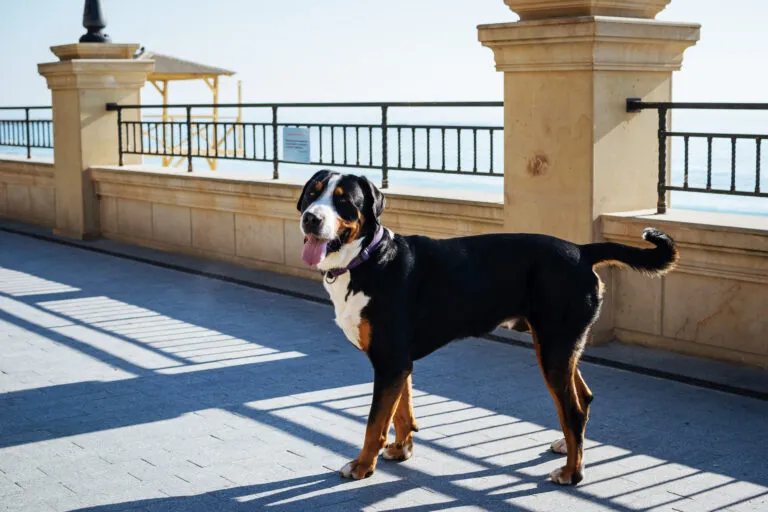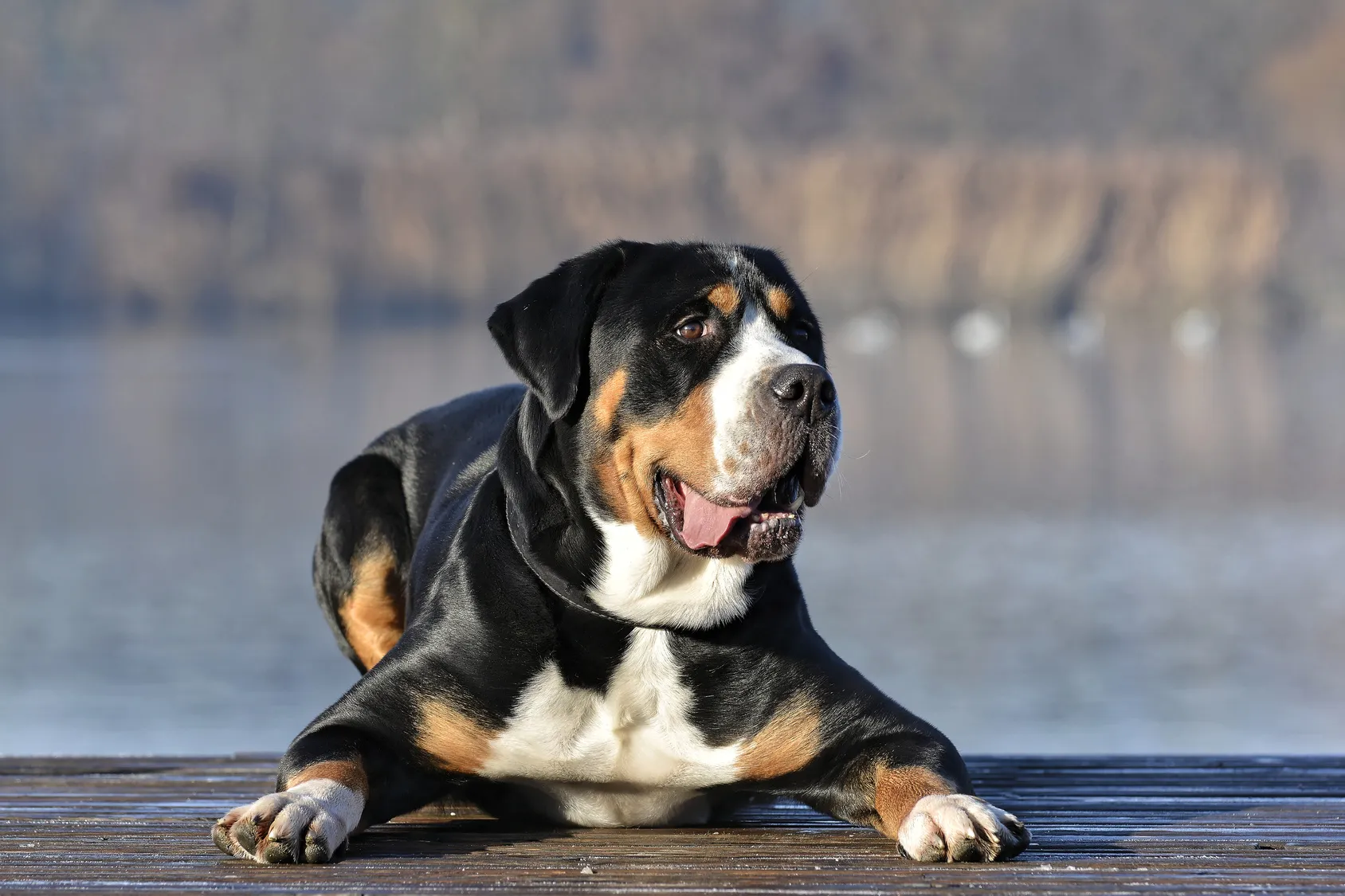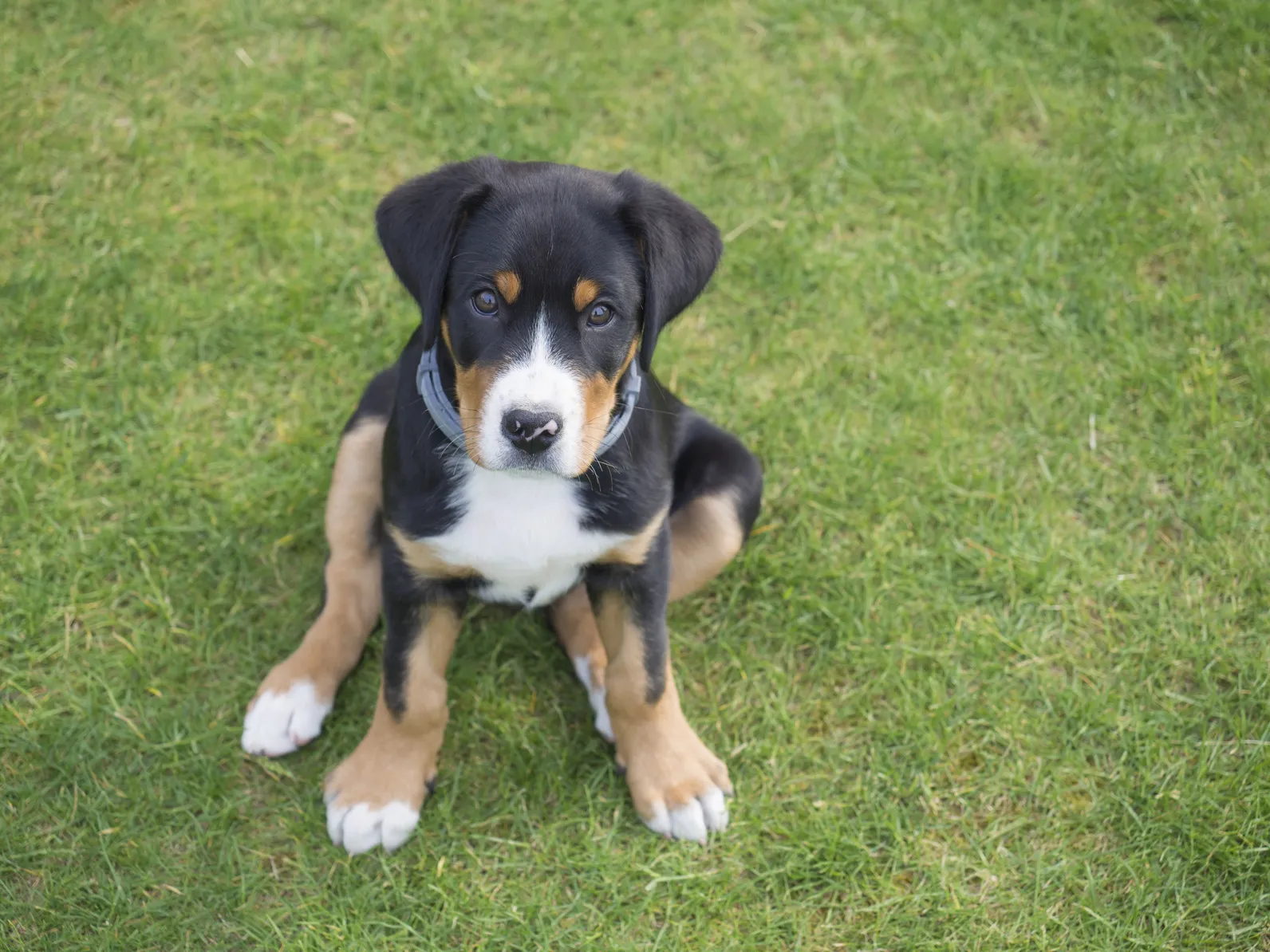Beagle
The Beagle's short legs can be deceiving – this medium-sized dog keeps you on your toes and is always full of surprises! This friendly breed is active, fearless and extremely clever.
With its short fur and typical tricolour tinge, the Greater Swiss Mountain Dog is an attentive guardian and tenacious worker, as well as a child-friendly, cuddly family dog. Reaching a shoulder height of up to 72cm, it is the biggest and heaviest of the four acknowledged Mountain Dog breeds.

© sashafolly / stock.adobe.com
Nothing easily flusters the sturdy Greater Swiss Mountain Dog with its strong bone structure. Strangers, loud school children, barking dogs or smelly tractors don’t affect its even-tempered nature. These attentive guardians have a natural protective instinct, with hardly anything making them nervous. However, aggressive or anxious behaviour is totally alien to these calm Swiss dogs.
Nevertheless, this breed demonstrates a strong protective behaviour toward their caregivers as traditional house and farm dogs. They immediately announce the presence of strangers who approach their territory. Their reticence towards “intruders” is quickly put aside as soon as it recognises them as friends of their family. These sociable pedigree dogs love their family above all and are always looking to be close to them. These good-natured giants get on particularly well with children and always stay close to them as playmates, babysitters and guardians.
As much as they love their family, Greater Swiss Mountain Dogs also need species-appropriate tasks. They like to do exercise and to have a purpose. They have always been passionate hauling dogs. To this day, they enthusiastically pull sleighs or dogcarts or take their owner’s shopping bags home. Thanks to their high intelligence and love of learning, these Swiss dogs soon grasp what is expected of them. However, these otherwise obedient dogs do show their stubborn side if a task appears pointless or futile to them. If you understand this and always present your dog with new challenges, you will find these dogs straightforward and adaptable.
As is the case with all four Swiss Mountain Dogs, the Greater Swiss is characterised by its attractive tricolour fur. The black base colour covers the torso, throat, head and tail like a cloak. A symmetrical white blaze starts on the forehead and becomes wider towards the snout. The reddish-brown markings on the cheeks, limbs and to the side of the white chest fur complete the tricolour effect. The Mountain Dog’s “double eyes” are a typical feature, which come about due to the reddish-brown marks above the eyes.
In contrast to the Bernese Mountain Dog, its well-known relative, the Greater Swiss Mountain Dog has short top hair. The thick stock hair has a soft undercoat, offering the Mountain Dog reliable protection from the cold and the rain. A further but less significant difference to the Bernese Mountain Dog is its size. With males reaching a shoulder height of 65 to 72cm and females 60 to 68cm, they are generally two centimetres taller than their relatives from Bern.
The Greater Swiss Mountain Dog is characterised by its stocky, muscular body with a strong bone structure, making it predestined to carry and drag heavy loads. Despite its size and considerable weight of 45 to 65kg, this breed is very mobile and tenacious. It loves to be needed and is willing to work at all times. If something attracts its attention, the medium-sized triangular ears point forwards. They lie flat to the large, powerful head when at rest.
 © anzze86 / stock.adobe.com
© anzze86 / stock.adobe.com
The ancestors of the Greater Swiss Mountain Dog were also characterised by a huge powerful body that is muscular and mobile rather than portly and have gone down in history as meat and butcher’s dogs. They were widespread in Central Europe at the end of the 19th century, especially in Switzerland, and were deployed by butchers, farmers, cattle traders and craftsmen as draught dogs, cattle herders and guard dogs.
Six years after Bernese Mountain Dogs (then still known as Dürrbächler) were shown for the first time at a canine exhibition, a male was presented in 1908 at the anniversary exhibition of the Swiss Cynological Society (Schweizerische Kynologische Gesellschaft, SKG) that had the attractive tricolour fur, though it was short in length. It was to the credit of the Swiss geologist and cynologist Prof. Dr. Albert Heim, who was then employed as a breeding judge and had already collaborated on a standard for the Bernese Mountain Dog, that this short-haired dog was granted particular attention. Together with the male’s owner Franz Schertenleib, he searched for more short-haired females that could be used for breeding. Only a year later, it was accepted into the Swiss Dog Stud Book with the name Greater Swiss Mountain Dog.
In contrast to the successful breeding of the Bernese Mountain Dog, which became well-known beyond the borders of Switzerland soon after its discovery, the breeding base of the Greater Swiss remained manageable. The club for Greater Swiss Mountain Dogs founded in 1912 only changed slightly in this respect at first. Only after the Second World War when the Swiss army came to value these robust and reliable dogs for their hauling and carrying qualities did entries in the Swiss Dog Stud Book come to be somewhat more regular. However, the Greater Swiss remains quite a rare breed to this day compared to the Bernese and Appenzeller Mountain Dogs. Only around 120 Greater Swiss puppies are born each year.
Although this breed is less widespread compared to the Bernese Mountain Dog, this doesn’t mean you should go for the first puppy offer that comes up. A dog should never be purchased in haste, regardless of whether it’s an Appenzeller, Bernese, Entlebucher or Greater Swiss Mountain Dog. If you’re interested in Mountain Dogs, you should at first become familiar with the special unique features of these breeds and the differences between them. What are the requirements for keeping each breed? Are these dogs suitable for city living? How much time is needed for grooming, activity and training? Breeding associations, breeders and Mountain Dog owners can give you helpful answers to these questions based on practical experience.
Once you’ve opted for a Greater Swiss Mountain Dog, you then need to choose the right breeder. But what is “right” in this context? To start, breeders should of course be responsible, belonging to an association and adhering to its breeding guidelines. They should also come across as friendly and convince you that they put plenty of passion, experience and caution into their breed. It’s evident that this is only possible by meeting face-to-face. Breeders who sell their dogs over the phone or through newspaper or online ads and never invite you to their home do not fulfil these criteria. Hence, pay attention to the following points when choosing a breeder.
An important aspect in favour of purchasing a pedigree Mountain Dog from a responsible breeder is definitely the animal’s health. Before deployment, all breeding animals are tested for frequently occurring hereditary diseases. The results are documented and can be viewed at any time. Significant attention should be paid to examinations for potential joint diseases. Like almost all large and heavy dogs, this breed also tends to develop hip dysplasia (HD), elbow dysplasia (ED) or even osteochondritis dissecans (OCD). Thanks to strict breeding regulations and consistent exclusion of affected animals from the breeding process, the risk of disease can thankfully be reduced.
However, the emergence of joint problems does not depend solely on genetic material. Although HD, ED or OCD are often genetically determined, the dog’s diet and housing conditions also influence whether these diseases emerge. An incorrect diet and excess strain during the crucial growth phase in particular can lead to skeletal disorders at a later date. Overly quick growth that can be traced back to an excessive protein supply during the puppy phase generally causes problems. Hence, the Greater Swiss Mountain Dog should receive a low-protein food up until 18 months of age. This is particularly relevant for the main growth phase from three to six months. It’s important that the dog doesn’t receive too much or too little of the required nutrients. For instance, excess calcium leads to growth complications and an incorrect proportion of calcium to phosphorous.
There is no generic answer for each breed as to what nutrients a dog needs and in what proportion. This depends heavily on individual factors, such as age, sex, size, health, activity level and housing. If in doubt, take advice from your vet as to what your dog needs at what stage. However, the basic principle applies to every type of dog food that it should be high quality and provide dogs with all essential minerals and nutrients. An adult Greater Swiss Mountain Dog will cope fine with two meals a day. In contrast to fresh drinking water, which should always be available to your dog, you should be restrictive in terms of its food. Greater Swiss Mountain Dogs tend to gain excess weight and unfortunately develop dreaded stomach twist. The risk of both can be reduced though with a cautious diet and fixed practical mealtimes.
Grooming is very easy thanks to the short fur, which only takes in low quantities of dirt. Regular cleaning with a brush is more than sufficient. If your dog is very dirty after a forest walk or bathing in mud, you can wash it down. You should only use dog shampoo in very low quantities or not at all, because otherwise it could damage the hair structure and skin barrier.
If you have a puppy at home, you should take into account when assigning tasks and with the associated exercise level that your young dog’s joints should not be put under too much strain. In order to prevent later misalignments and signs of wear, puppies should not climb any stairs if possible during the growth phase, not play or jump on hard surfaces and not carry or pull excessively heavy weights. Adult dogs too should be kept in ground-level homes if possible where they rarely need to climb stairs.
 © Kristyna / stock.adobe.com
© Kristyna / stock.adobe.com
As the name suggests, the Greater Swiss Mountain Dog needs plenty of space, therefore city living is only suitable to a certain extent. However, a large garden alone is not enough for these pedigree dogs to feel at ease. Along with a worthwhile and fulfilling activity, these affectionate Swiss dogs primarily need love and attention. They especially seek out the company of their owner during evenings or after a long walk. People who grant them attention and a feeling of security are rewarded with an incredibly loyal and good-natured dog. Despite its reputation for occasional stubbornness, the Greater Swiss Mountain Dog is a docile and generally easy-to-lead dog that willingly submits to its owners.
The Beagle's short legs can be deceiving – this medium-sized dog keeps you on your toes and is always full of surprises! This friendly breed is active, fearless and extremely clever.
The Golden Retriever is still one of the most popular dog breeds, especially with families. It is defined not just by its docility, but shows numerous other qualities too. Read in the following article everything you need to know about the Golden Retriever.
The German Shepherd is one of the most popular utility dog breeds in the world, though the willing-to-learn and people-focused nature of these versatile dogs also makes them suitable for family life.